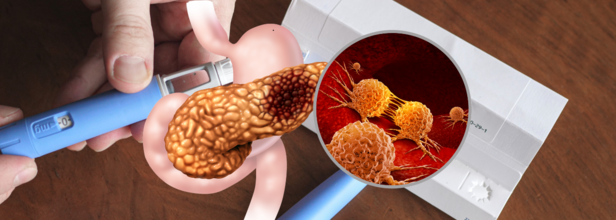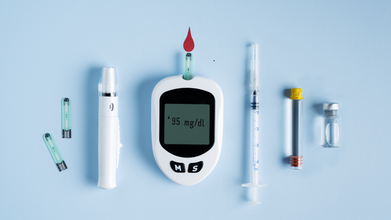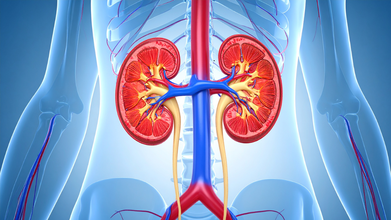- Health Conditions A-Z
- Health & Wellness
- Nutrition
- Fitness
- Health News
- Ayurveda
- Videos
- Medicine A-Z
- Parenting
Weight Loss Drugs Like Ozempic, Mounjaro And Wegovy Under Scrutiny After Deaths And Pancreatitis Reports in UK

Credits: Canva
The Health and Me had previously reported on how many people faced problems with their pancreas post taking weight loss drugs and diabetes injections. These medicines are mostly Wegovy, Ozempic and other variants of GLP-1 medicines, or the glucagon-like peptide-1 receptor agonists. This has led to an investigation by the authorities.
Not just this, but there are also reports of deaths that have been linked with GLP-1 medicines. Data from the Medicines and Healthcare products Regulatory Agency (MHRA) revealed that ever since these drugs were approved, there have been hundreds of cases of acute and chronic pancreatitis.
The data revealed that 10 people have died and among them, 5 were linked to active ingredients of these popular weight loss jabs.
What Did The Data Reveal?
- A total of 181 cases of acute and chronic pancreatitis have been reported in connection with tirzepatide, the active ingredient in Mounjaro, including five fatalities.
- Liraglutide was associated with 116 such cases, one of which was fatal.
- Semaglutide—the active ingredient in Ozempic and Wegovy—was linked to 113 cases, with one death reported.
- Exenatide was associated with 101 cases, including three deaths.
- Dulaglutide and lixisenatide were linked to 52 and 11 cases respectively, with no reported fatalities for either drug.
Based on the data, the Yellow Card Biobank project, which is launched by MHRA and Genomics England will investigate these instances and check whether these drugs could influence people's genetic make-up.
When we asked Dr Amrit Kaur Kaler, Consultant, Molecular Pathology at Kokilaben Dhirubhai Ambani Hospital, Mumbai about it, she said the "definitive answer to it is no". The doctor explained, "GLP-1 drugs are designed to mimic the body’s own incretin hormone. Once injected, they bind to GLP-1 receptors located on pancreatic β-cells and in regions of the brain that regulate appetite. This action leads to an enhanced insulin secretion, helping the body respond appropriately to rising blood glucose levels." It also leads to appetite suppression, by activating neurocircuits that signal fullness. Furthermore, it delays gastric emptying, which prolongs satiety after meals.
In a nutshell, explained the doctor, the medicines "target receptors, not genes."
Though Dr Kaler also notes, "Although GLP-1 agonists themselves do not rewrite genes, any significant change in metabolism—such as substantial weight loss or improved insulin sensitivity—can lead to epigenetic modifications. These are biochemical tweaks, like adding or removing methyl groups on DNA or changing histone configurations, that influence gene activity without altering the underlying sequence." However, it is also important to note that the drugs do not introduce new mutations or make the pancreas produce abnormal DNA. "Individuals with inherited variants in genes like PRSS1, SPINK1, or CFTR already carry a higher baseline risk for pancreatitis," she explains.
The MHRA is encouraging individuals taking GLP-1 medicines who have been hospitalised with acute pancreatitis to report their experience through the Yellow Card scheme.
Following a report submission, the MHRA will reach out to patients to ask if they are willing to take part in a related study.
Participants will be asked to share further information and provide a saliva sample to help determine whether genetic factors may contribute to the risk of developing acute pancreatitis from specific medications.
What Are GLP-1 Medicines?
GLP-1 agonists, used to lower blood sugar in type 2 diabetes and support weight loss, are currently under increased scrutiny, according to Wales Online.
With an estimated 1.5 million people in the UK using weight loss injections, health authorities recognise their role in tackling obesity but warn against viewing them as a universal solution, citing potential side effects.
Commonly reported reactions include nausea, constipation, and diarrhoea. Recent safety alerts have also highlighted concerns about Mounjaro possibly reducing the effectiveness of oral contraceptives.
Dr. Alison Cave, Chief Safety Officer at the MHRA, stated: “Evidence shows that nearly a third of medicine-related side effects could be avoided through genetic testing. Adverse drug reactions are estimated to cost the NHS over £2.2 billion annually in hospital admissions alone.”
She added that data gathered from the Yellow Card Biobank will help identify patients at increased risk of side effects, enabling more personalised and safer prescribing based on individual genetic profiles.
What Happens To Your Body When GLP-1 Medicines Are Administered?
To understand what our body goes through, we spoke to experts in endocrinology and gastroenterology. Here's what they said.
Dr Pranav Ghody, Consultant Endocrinologist & Diabetologist, Wockhardt Hospitals at Mumbai Central explains that weight loss medications, particularly injectable GLP-1 receptor agonists like semaglutide, have become popular due to their effectiveness. "However, when misused taken without medical supervision, used in high doses, or by people with underlying health issues they can lead to serious side effects. Some complications, like pancreatitis or severe gastrointestinal symptoms, may be life-threatening if not promptly addressed."
Why does it impact the pancreas? Dr Ghody explains that these medicines slow digestion and help control hunger, however, in some individuals, especially those predisposed or with a history of pancreatic issues, they can irritate the pancreas and trigger inflammation, leading to a condition called acute pancreatitis.
He also notes that in rare cases, acute pancreatitis can become severe. "It could lead to serious complications like organ failure of infections. If not diagnosed and managed early, it can be fatal. That said, such outcomes are uncommon and typically occur when early warning signs are ignored or the drug is misused."
Dr Saswata Chatterjee, Gastroentrologist at CMRI Hospital explained, "Cases of pancreatitis is more commonly seen in patient people who take terezaberatide. What occurs is there is a pancreatic duct through which the normal pancreatic secretions flow out of the pancreas and into the small intestine. This medicine has been shown to cause hyperplasia of cells around the pancreatic duct and therefore ductal occlusion occurs which leads to pancreatitis in some situations."
Dr Kashish Gupta, Consultant Endocrinology at PSRI Hospital, Delhi, points out that deaths reported in association with these drugs are usually related to severe complications like pancreatitis, dehydration, electrolyte imbalances, or cardiac issues in patients who were either not properly monitored or had other underlying health risks. "Sometimes, patients also self-medicate or receive these injections without adequate clinical oversight, which adds to the risk."
He further adds, "People should be made aware of early warning signs of pancreatitis such as sudden, severe abdominal pain that radiates to the back, persistent nausea, vomiting, and fever. If such symptoms occur, the medication must be stopped immediately and emergency medical care sought."
So, How Can One Ensure Safe Use Of Weight Loss Drugs?
"Always take these drugs under the guidance of a qualified endocrinologist or physician. A thorough evaluation including your medical history, current health status, and regular monitoring is crucial. Never self-medicate or take someone else’s prescription. Also, report any symptoms like persistent stomach pain, nausea, or vomiting immediately to your doctor," points out Dr Ghody.
Seconding to this. Dr Sachin Chittawar, Endocrinologist notes that drugs should be prescribed by an endocrinologist.
Who Was Ludwig Minelli, Founder of the Swiss Right-to-Die Organization, Who Died by Assisted Suicide at 92?

Credits: AP
Ludwig Minelli, 92, died on Saturday just days before his 93rd birthday, which would have been on December 5. He was the founder of Swiss right-to-die organization Dignitas. He has died by assisted suicide.
The members of organization paid tribute to him and said that he had always led a "life for freedom of choice, self-determination, and human rights".
Right-To-Die By Minelli
Minelli founded Dignitas in 1998, which has helped many people to choose how they wish to die with dignity. He however began his career as a journalist and worked as a correspondent for the German news magazine Der Spiegel. He then studied law and that is when his interest in human rights took off.
Throughout his life, he campaigned for the right to die and gave Dignitas the slogan: "dignity in life, dignity in death".
"I am persuaded that we have to struggle in order to implement the last human right in our societies. And the last human right is the right to make a decision on one's own end, and the possibility to have this end without risk and without pain," he said in a 2010 BBC interview.
He founded Dignitas after he split from an older Swiss assisted dying organization, Exit, because he said the rules felt too restrictive.
The reason for Dignitas to become famous was because the way it operated. Dignitas offered assisted suicide to non-Swiss citizens who travel to Switzerland because assisted dying is not permitted in their own countries. In a 2008 interview to Der Tagesspiegel, he said that Dignitas assisted 840 people to die, and 60% of them were Germans.
His Life Amid Criticism And Legal Battles
While he devoted his life for a cause, he was not spared from criticism. He was often criticized for an alleged lack of transparency over the financial dealings of the organization. He was further criticized for offering assisted dying options to those who were not terminally ill, but wanted to end their lives. He also faced numerous legal battles, and many of which were also appealed to Swiss apex court.
The Wins He Made
As per Dignitas, his work had a lasting influence. In 2011, the European Court of Human Rights announced the right of a person capable of judgment to decide on the manner and the time of their own end of life.
While in his own country, assisted dying was permitted under Swiss law since 1942, under strict condition, of course, Euthanasia still remains illegal there.
The main difference is that in Switzerland, a physician cannot administer a lethal injection, which is what euthanasia is. However, a physician can provide the means for a person to end their own life, and the individual must perform the final act themselves.
The legality of assisted suicide is based on Article 115 of the Swiss Criminal Code from 1942, which prohibits assistance only if motivated by selfish reason. The conditions for assisted suicide includes that the assistance must not be for selfish motives and must be provided to someone of sound mind who has made a self-determined and enduring decision to die. The person must also be suffering from an unbearable and uncontrollable condition.
Your Butt Shape Could Be a Clue to Your Diabetes Type; Here’s How

Credits: Canva
The shape of your gluteus maximus, the largest muscle in your backside, may offer surprising clues about your likelihood of developing diabetes. New research suggests that the contours of this major muscle change with age and health conditions, helping scientists better understand how fitness, muscle health, and metabolism are connected.
Ageing, Weight, and Diabetes: What We Already Know
For years, the NHS has warned that ageing and excess weight increase the risk of developing Type 2 diabetes. However, this new study goes beyond traditional measures, proposing that the shape of the gluteus maximus itself shifts as people age or develop conditions such as osteoporosis or diabetes. These subtle muscular changes could provide valuable information about a person’s metabolic health.
Why the Gluteus Maximus Matters
Researchers from the University of Westminster highlighted that the gluteus maximus plays a key role not just in movement but also in metabolic regulation. Healthy, well-maintained muscles can improve blood sugar control and reduce the burden on organs involved in glucose processing.
Dr Marjola Thanaj, co-author of the study from the university’s Research Centre for Optimal Health, explained, as reported by Independent: “People with higher fitness, as measured by vigorous physical activity and hand grip strength, had a greater gluteus maximus shape, while ageing, frailty and long sitting times were linked to muscle thinning.”
Mapping the Muscle
To understand these differences, researchers used advanced MRI 3D mapping to create a detailed anatomical model of the gluteus maximus. By analyzing more than 61,000 MRI scans from the UK Biobank database, they discovered that the shape, not the size, of the muscle varied significantly between individuals with diabetes and those without it.
What the Study Found
The MRI analysis revealed distinct, sex-specific patterns linked to Type 2 diabetes. Among male participants living with the disease, those classified as “frail” showed widespread muscle shrinkage across the gluteus maximus, indicating a loss of muscle quality and strength.
Women with diabetes, on the other hand, had enlarged muscle shapes — not because of increased muscle strength, but because of fat infiltrating the muscle tissue. This type of fat infiltration often signals declining muscle function and poorer metabolic health.
Dr Thanaj said these patterns underline a crucial point: men and women can experience the same illness in very different biological ways, which may influence diagnosis and treatment strategies in the future.
Why Maintaining Muscle Mass Matters
Beyond appearance or strength, muscle health is essential for long-term wellbeing. Maintaining muscle mass supports blood sugar regulation, reduces the risk of cardiovascular disease, and lowers the likelihood of developing fatty liver disease, all conditions closely linked to metabolic health.
Professor Louise Thomas, senior author of the study, told The Times: “Maintaining muscle mass as we age is one of the most important things we can do for our long-term health. If people understand how important their muscles are, and make small changes to keep them healthy, that could have a huge impact on disease across the population.”
Small Steps to Strengthen Your Glutes
Improving glute muscle health doesn’t require intense gym sessions. Simple actions such as taking the stairs instead of the lift, adding squats or lunges to your routine, or breaking up long periods of sitting can help tone and strengthen the gluteus maximus.
4 Simple Tests That Can Detect Kidney Diseases Early, According To Doctor

Credits: Canva
Kidney disease is rising at an alarming pace worldwide, and it’s now among the top causes of death. A Lancet study highlights that the number of people living with chronic kidney disease jumped from 78 million in 1990 to nearly 788 million in 2023. That’s a massive tenfold spike, and a reminder that our kidneys need more attention than we realize.
The tricky part? Kidney problems often progress silently. Many people don’t realize anything is wrong until the kidneys are already significantly damaged. That’s why experts strongly emphasize early screening. According to nephrologists like Dr Arjun Sabharwal, a few simple tests — often quick and inexpensive — can help catch kidney issues early and improve treatment outcomes.
Below are the four key tests everyone should know about, especially if you have diabetes, high blood pressure, a family history of kidney disease, or you’re simply trying to stay proactive about your health.
Creatinine Blood Test & eGFR: Your First Kidney Health Check
Creatinine is a waste product filtered out by the kidneys. A routine blood test measures its level, but creatinine alone doesn’t tell the full story. That’s where eGFR (Estimated Glomerular Filtration Rate) comes in.eGFR uses creatinine values along with age and other factors to estimate how well your kidneys are functioning overall. Doctors often say, “Creatinine is just a number — eGFR tells you how much your kidneys are working.”
An eGFR below normal may be an early signal that your kidneys aren’t filtering efficiently, even if you feel fine.
Cystatin C: A More Accurate Indicator for Some People
Cystatin C is a protein produced naturally by all cells. When kidneys are healthy, its levels stay stable; when the kidneys struggle, the levels rise.
Experts highlight that Cystatin C can be more reliable than creatinine for people with very high muscle mass, those who work out intensely, or individuals taking supplements that may affect creatinine readings. If creatinine results seem unclear or inconsistent, this test adds clarity.
Urine Dipstick Test: Quick and Tells You a Lot
Before kidney function takes a major hit, the body often shows early warnings — one of which is protein leakage in urine. A urine dipstick test is one of the fastest ways to detect this.
A chemically treated strip is dipped into your urine sample, and if proteins like albumin are present, the strip changes color. It’s simple, non-invasive, and helpful for spotting early kidney damage.
Urine Protein-to-Creatinine Ratio (UPCR): How Much Protein Is Leaking
If a dipstick shows abnormalities, the next step is often a UPCR test. This test measures exactly how much protein is leaking into the urine relative to creatinine. Higher levels may signal worsening kidney function or underlying disease. Doctors use UPCR to assess the severity of kidney damage and monitor progress over time.
When to See a Nephrologist
If any test shows rising creatinine, an abnormal eGFR, protein in urine, or blood detected on a dipstick, it’s crucial to book an appointment. Lifestyle tweaks, home remedies, or detox drinks cannot reverse kidney damage. Expert evaluation is essential.
© 2024 Bennett, Coleman & Company Limited

